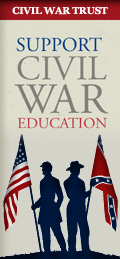|
Two books provide new insight into soldier experience
By Lisa Brady
The Journal of Military History
April 2005
Individual experience is the foundation of history; without examining the motivations and repercussions of individuals' actions, history becomes a faceless, uninteresting chronology. Both Mark Dunkelman in Brothers One and All and Ronald Coddington in Faces of the Civil War clearly understand this principle and provide important and compelling stories of a few of the individuals who fought for the Union during the American Civil War.
Dunkelman examined the 154th New York Volunteer Infantry in Brothers One and All and suggested that the unit was representative of Union regiments not only in terms of its traditional regimental history, but, more importantly, in its development of unit loyalty. Dunkelman divided his book into three parts: In "Home Ties" Dunkelman traced the regiment's origins in two western New York counties and the close connections the men had in terms of family and community relations; "War Ties" followed the men through recruitment, camp life, combat, and mustering out, "Veteran Ties" examined the regiment's postwar history. Dunkelman argued throughout that the common backgrounds and shared experiences provided the foundation for an abiding bond among the members of the 154th that went beyond simple allegiance to their comrades to a true devotion of the regiment itself — what Dunkelman caled espirit de corps. Dunkelman concluded that little could diminish the reverence the men deveoped for their unit — not physical hardship, desertion, personal animsity, not even the end of the war — only the passing of its last veteran in 1934 brought the end of the 154th's espirit de corps.
The existence of unit loyalty is not a new discovery, though as Dunkelman pointed out, it is a relatively neglected aspect of Civil War history. Many historians have noted the importance of espirit de corps, but few have delved as deeply into its origins and meanings as Dunkelman. His exhaustive research included the regiment's official records as well as over one thousand letters and two dozen diaries kept by the soldiers of the 154th; extensive quotes from these sources providing compelling evidence of the regiment's sense of espirit de corps. On occasion Dunkelman's use of primary material seemed tenuous support for his espirit de corps thesis, and appeared to be included more out of a desire to fully utilize his sources, but this does not unduly detract from the overall significance of the book. Brothers One and All is an important and useful book for understanding not only why individual soldiers identified so strongly with their regiments, but also why that identification remained so powerful after the fighting ended.
Where Dunkelman focused on the individual's role in the creation of unit loyalty, the unit is of secondary (if not lesser) importance in Coddington's Faces of the Civil War; indeed, Coddington's book is devoted entirely to relating the unique stories of individual soldiers. There is no underlying argument in Coddington's book, but this does not detract from its significance; in fact, it is its strength. Faces of the Civil War came out of Coddington's early interest in cartes de visite, the nineteenth-century version of today's business cards. On enlistment in the Union Army, many new recruits had their photographs taken to give to their family, friends, and comrades, both as keepsakes and as proof of their transformation from civilian to soldier (see Michael Fellman's able foreword to the book for the history of cartes de visite). Seventy-seven of these photographs are included in Coddington's book, each with a brief history of the soldier, his service, and, for those who survived the war, his postwar life. The collection is a fascinating window into the war's impact on the individual soldier. Coddington's histories are well-researched and engagingly written. Any teacher of the Civil War would do well to consult this volume and incorporate some of the captivating tales into lectures and readings.
All students of the Civil War will benefit from these two books, though Coddington's work will likely be more accessible to a popular audience. Both contain solid research and both provide new insight into the individual experiences of the millions whose stories might otherwise be lost to history.
|
|
